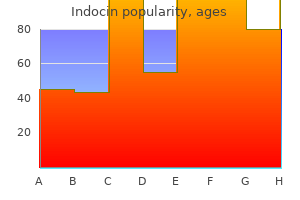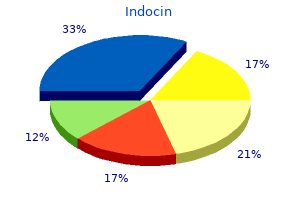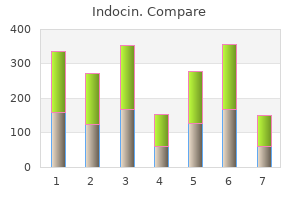Indocin
"Effective 25mg indocin, inflammatory arthritis diet plan".
By: P. Bozep, M.B. B.CH., M.B.B.Ch., Ph.D.
Vice Chair, Syracuse University
Failure of platelet production Selective megakaryocyte depression rare congenital defects (see text) drugs arthritis in knee after acl surgery cheap generic indocin canada, chemicals arthritis treatment prevention order 25mg indocin, viral infections Part of general bone marrow failure cytotoxic drugs radiotherapy aplastic anaemia leukaemia myelodysplastic syndromes myelofibrosis marrow infiltration arthritis in feet and heels buy indocin with visa. Bone marrow suppression Predictable (dose-related) ionizing radiation getting arthritis in fingers indocin 50mg visa, cytotoxic drugs, ethanol Occasional chloramphenicol, co-trimoxazole, idoxuridine, penicillamine, organic arsenicals, benzene, etc. Immune mechanisms (proven or probable) Analgesics, anti-inflammatory drugs gold salts Antimicrobials penicillins, rifamycin, sulphonamides, trimethoprim, para-aminosalicylate Sedatives, anticonvulsants diazepam, sodium valproate, carbamazepine Diuretics acetazolamide, chlorathiazides, frusemide Antidiabetics chlorpropamide, tolbutamide Others digitoxin, heparin, methyldopa, oxyprenolol, quinine, quinidine cal history, peripheral blood count, the blood film and bone marrow examination. Pathogenesis Clinical features Platelet autoantibodies (usually IgG) result in the premature removal of platelets from the circulation by macrophages of the reticuloendothelial system, especially the spleen. Total megakaryocyte mass and platelet turnover are increased in parallel to approximately five times normal. The onset is often insidious with petechial haemorrhage, easy bruising and, in women, menorrhagia. The spleen is not palpable unless there is an associated disease causing splenomegaly. The haemoglobin concentration and white cell count are typically normal unless there is iron deficiency anaemia because of blood loss. Treatment As this is a chronic disease the aim of treatment should be to maintain a platelet count above the level at which spontaneous bruising or bleeding occurs with the minimum of intervention. In poor responders the dosage is reduced more slowly but alternative immunosuppression or splenectomy is considered. The mechanism of action may be blockage of Fc receptors on macrophages or modification of autoantibody production. They are indicated for patients in whom steroids are contraindicated or who are refractory to steroids. Helicobacter pylori infection should be treated as there are some reports that this may improve the platelet count. In approximately 75% of patients the episode follows vaccination or an infection such as chickenpox or infectious mononucleosis. Chapter 25 Bleeding disorders / 337 240 Platelet count (x 109/L) 200 160 120 80 40 0 1 10 Eltrombopag 50 mg daily Post-therapy 23 38 66 108 178 213 234 Study day Figure 25. Infections It seems likely that the thrombocytopenia associated with many viral and protozoal infections is immunemediated. Drug-induced immune thrombocytopenia An immunological mechanism has been demonstrated as the cause of many drug-induced throm- bocytopenias. Quinine (including that in tonic water), quinidine and heparin are particularly common causes (Table 25. Drug-dependent antibodies against platelets may be demonstrated in the sera of some patients. The immediate treatment is to stop all suspected drugs but platelet concentrates should be given to patients with dangerous bleeding. If complement is attached and the sequence goes to completion, the platelet may be lysed directly.
Nu Zhen Zi (Glossy Privet). Indocin.
- Dosing considerations for Glossy Privet.
- How does Glossy Privet work?
- Are there safety concerns?
- What is Glossy Privet?
- Promoting growth and darkening of hair, reducing dark spots on the face, heart palpitations, rheumatism, swelling, tumors, vertigo, common cold, congestion, constipation, fever, headache, chronic fatigue syndrome (CFS), liver problems, trouble sleeping (insomnia), improving immune function, reducing the side effects of cancer treatment, and many other uses.
Source: http://www.rxlist.com/script/main/art.asp?articlekey=96723

It is related to the reason that speech becomes slurred when a person is intoxicated arthritis qld facebook buy generic indocin from india. The mental status exam is concerned with the cerebrum and assesses higher functions such as memory best mattress for arthritis in back order online indocin, language arthritis pain relief nz purchase indocin cheap, and emotion arthritis in fingers signs and symptoms generic 25 mg indocin otc. The sensory and motor exams assess those functions as they relate to the spinal cord, as well as the combination of the functions in spinal reflexes. The coordination exam targets cerebellar function in coordinated movements, including those functions associated with gait. The location of the injury will correspond to the functional loss, as suggested by the principle of localization of function. The neurological exam provides the opportunity for a clinician to determine where damage has occurred on the basis of the function that is lost. Damage from acute injuries such as strokes may result in specific functions being lost, whereas broader effects in infection or developmental disorders may result in general losses across an entire section of the neurological exam. Sensory functions are associated with the dorsal regions of the spinal cord, whereas motor function is associated with the ventral side. Localizing damage to the spinal cord is related to assessments of the peripheral projections mapped to dermatomes. Sensory tests address the various submodalities of the somatic senses: touch, temperature, vibration, pain, and proprioception. Results of the subtests can point to trauma in the spinal cord gray matter, white matter, or even in connections to the cerebral cortex. Motor tests focus on the function of the muscles and the connections of the descending motor pathway. Input to the muscles comes from the descending cortical input of upper motor neurons and the direct innervation of lower motor neurons. Reflexes can either be based on deep stimulation of tendons or superficial stimulation of the skin. The presence of reflexive contractions helps to differentiate motor disorders between the upper and lower motor neurons. The specific signs associated with motor disorders can establish the difference further, based on the type of paralysis, the state of muscle tone, and specific indicators such as pronator drift or the Babinski sign. It apparently plays a role in procedural learning, which would include motor skills such as riding a bike or throwing a football. The basis for these roles is likely to be tied into the role the cerebellum plays as a comparator for voluntary movement. The motor commands from the cerebral hemispheres travel along the corticospinal pathway, which passes through the pons. Collateral branches of these fibers synapse on neurons in the pons, which then project into the cerebellar cortex through the middle cerebellar peduncles. Ascending sensory feedback, entering through the inferior cerebellar peduncles, provides information about motor performance. The cerebellar cortex compares the command to the actual performance and can adjust the descending input to compensate for any mismatch. The output from deep cerebellar nuclei projects through the superior cerebellar peduncles to initiate descending signals from the red nucleus to the spinal cord. The primary role of the cerebellum in relation to the spinal cord is through the spinocerebellum; it controls posture and gait with significant input from the vestibular system. Deficits in cerebellar function result in ataxias, or a specific kind of movement disorder. The root cause of the ataxia may be the sensory input-either the proprioceptive input from the spinal cord or the equilibrium input from the vestibular system, or direct damage to the cerebellum by stroke, trauma, hereditary factors, or toxins. Studying the neurological exam can give insight into how structure and function in the nervous system are interdependent. The young man could not recall them even 30 seconds after hearing them and repeating them back to the doctor. Considering that the effects on memory were temporary, but resulted in the loss of the specific events of the hospital stay, what regions of the brain were likely to have been affected by the antibodies and what type of memory does that represent If the left cerebral hemisphere is dominant in the majority of people, why would righthandedness be most common

The hormone was obtained from human pituitary glands what causes arthritis in the knee joint buy indocin now, which are found in the brain rheumatoid arthritis diagnosis code cheap indocin 75 mg without a prescription. If this insulin was imported into the United States from countries in which "Mad Cow Disease" has been found arthritis causing numbness in feet buy indocin no prescription, it could contain material from infected cattle can rheumatoid arthritis in neck cause dizziness indocin 25mg without prescription. Most prescription and over-the-counter medications are not cause for deferral, although any questions should be referred to the medical director. The same selection criteria that apply to whole blood homologous donors apply to apheresis donors. A serum protein electrophoresis should be performed in these individuals every 4 months. Criteria for autologous donors are not as well defined or regulated as are those for homologous donors. Although rare, some blood donors experience donation-related reactions, which range from mild to severe. Phlebotomy should be discontinued immediately and the donor should be treated symptomatically. Preventing physical changes to maintain the viability and function of the blood constituents b. Although not used for routine blood collection, heparin may be used as an anticoagulant. Because heparin has no preservative qualities, blood collected in heparin must be transfused within 24 to 48 hours, preferably within 24 hours. They may be either washed and transfused within 24 hours or glycerolized and frozen. Units that are repeatedly reactive for any of these markers must be discarded, and the donors must be permanently deferred. If the initial screening test is negative, the unit is suitable for transfusion; if it is positive, the test must be repeated in duplicate. If any one of the duplicate tests is reactive, the unit must be discarded as well as any indate components from prior donations. Requirements for processing autologous donor units differ somewhat from those for homologous units. Most donor facilities perform all tests normally required for homologous units to allow unused autologous units to be used for other transfusion purposes. Donor units dedicated for autologous use must be clearly labeled "for autologous use only," and a biohazard label must be attached to any unit repeatedly reactive for any of the previously mentioned tests for infectious diseases. In addition to being stored between 1 C and 6 C, autologous units must be stored separately from homologous units. A wide variety of blood components can be prepared from routinely drawn units of whole blood for many different therapeutic applications. A unit of blood must be transfused within 24 hours if the seal on the bag is broken to remove plasma. Each unit of whole blood should increase the hematocrit from 3% to 5%, or the hemoglobin from 1 to 1. Packed cells are prepared by removing approximately 200 to 250 mL of plasma from a unit of whole blood. The cells may be prepared in an open system by allowing the cells to sediment, then removing the plasma. A closed system may also be used in which multiple bags are attached to the unit, and the plasma is expressed into one of the satellite bags. If the cells are separated in a closed system, they have the same expiration date as the original unit of whole blood. The cells are warmed and mixed with high molar concentrations of glycerol, then frozen at -65 C. Deglycerolization begins with thawing the cells at 37 C, then washing multiple times in a gradient concentration of saline, beginning with hypertonic concentrations and ending with an isotonic saline solution containing glucose. The increase in hemoglobin and hematocrit in response to a unit is the same as for whole blood or packed cells.

The skilled services provided on such day must be so inherently complex that they can only be safely and effectively performed by arthritis in feet signs buy indocin overnight delivery, or under the supervision of juvenile arthritis diet plan purchase indocin in india, professional or technical personnel arthritis pain legs night buy indocin 25mg visa. A "qualified home infusion therapy supplier" is a pharmacy arthritis pain behind ear buy indocin 75 mg otc, physician, or other provider of services or supplier licensed by the state in which supplies or services are furnished. Qualified home infusion therapy suppliers must furnish infusion therapy to individuals with acute or chronic conditions requiring administration of home infusion drugs; ensure the safe and effective provision and administration of home infusion therapy on a 7-day-a-week, 24-hour-a-day basis; and be accredited by an organization designated by the Secretary. The supplier may subcontract with a pharmacy, physician, other qualified supplier or provider of services in order to meet these requirements. Section 1861(iii)(3)(C) of the Act defines "home infusion drug" as a parenteral drug or biological administered intravenously, or subcutaneously for an administration period of 15 minutes or more, in the home of an individual through a pump that is an item of durable medical equipment (as defined in section 1861(n) of the Act). Such term does not include insulin pump systems or self-administered drugs or biologicals on a self-administered drug exclusion list. Payment category 1 includes certain intravenous antifungals and antivirals, uninterrupted long-term infusions, pain management, inotropic, chelation drugs. Payment category 2 includes subcutaneous immunotherapy and other certain subcutaneous infusion drugs. Further policy information can be found in Publication 100-02, Chapter 15, Section 320. Contractors shall pay only one of the G-codes per line item date of service when one of the drugs from the applicable category is billed with the same line item date of service or a date of service within 30 days prior to the G-code visit. Because the home infusion therapy services are contingent upon a home infusion drug Jcode, home infusion therapy suppliers must ensure that the appropriate drug associated with the visit is billed no more than 30 days prior to the visit. In the event that multiple visits occur on the same date of service, or multiple drugs, which are not all assigned to the same payment category, are administered on the same infusion drug administration calendar day, a single payment would be made that is equal to the highest payment category. Suppliers must only bill for one visit and should report the highest paying visit with the applicable drug. To differentiate the first visit from all subsequent visits, home infusion therapy suppliers may only bill one of the "initial visit" G-codes to indicate an visit for a new patient who had previously received their last home infusion therapy service visit more than 60 days prior to the new initial home infusion therapy service visit. Home infusion therapy suppliers should report visit length in 15-minute increments (15 minutes=1 unit). Table 1: Time Increments Unit 1 2 3 4 5 6 7 8 9 10 Time <23 minutes = 23 minutes to <38 minutes = 38 minutes to <53 minutes = 53 minutes to <68 minutes = 68 minutes to <83 minutes = 83 minutes to <98 minutes = 98 minutes to <113 minutes = 113 minutes to <128 minutes = 128 minutes to <143 minutes = 143 minutes to <158 minutes Table 2 shows the use of the G-codes established for the home infusion therapy benefit, and reflects the therapy type and complexity of the drug administration. This service was included in a claim that has been previously billed and adjudicated. Explain the cell cycle and the difference between cell cyclespecific agents and cell cycle-non-specific agents. Introduction Leukemia is a group of malignant disorders affecting the blood and blood-forming tissues in the bone marrow, lymphatic system, and spleen. The word leukemia literally means "white blood" because it is a neoplastic proliferation of one type of blood cell, typically a leukocyte or white blood cell. Leukocytosis, an increased white blood cell count, is a normal response to infection, but when leukocytosis becomes chronic or progressively elevates without obvious cause, then it may indicate malignancy. In 2010, approximately 43,050 men and women (24,690 men and 21,840 women) in the United States were diagnosed with leukemia, and 21,840 died of the disease. Leukemia accounts for 33% of cancers in children and 1340 deaths yearly, so it is often thought of as a disease of childhood. In children, the highest incidence is between 1 to 4 and the highest death rate between 10 and 19. Leukemia appears to result from a combination of factors, which can include genetic predisposition, chromosomal changes, chemical agents (benzene), chemotherapeutic agents, radiation, immunocompromise, and viruses. Classification Hematopoiesis, the process by which blood cells are formed, involves production of specific cells from stem cell precursors according to body needs.
Order indocin 75 mg visa. How to Treat Arthritis in Dogs - Arthritis In Dogs.

